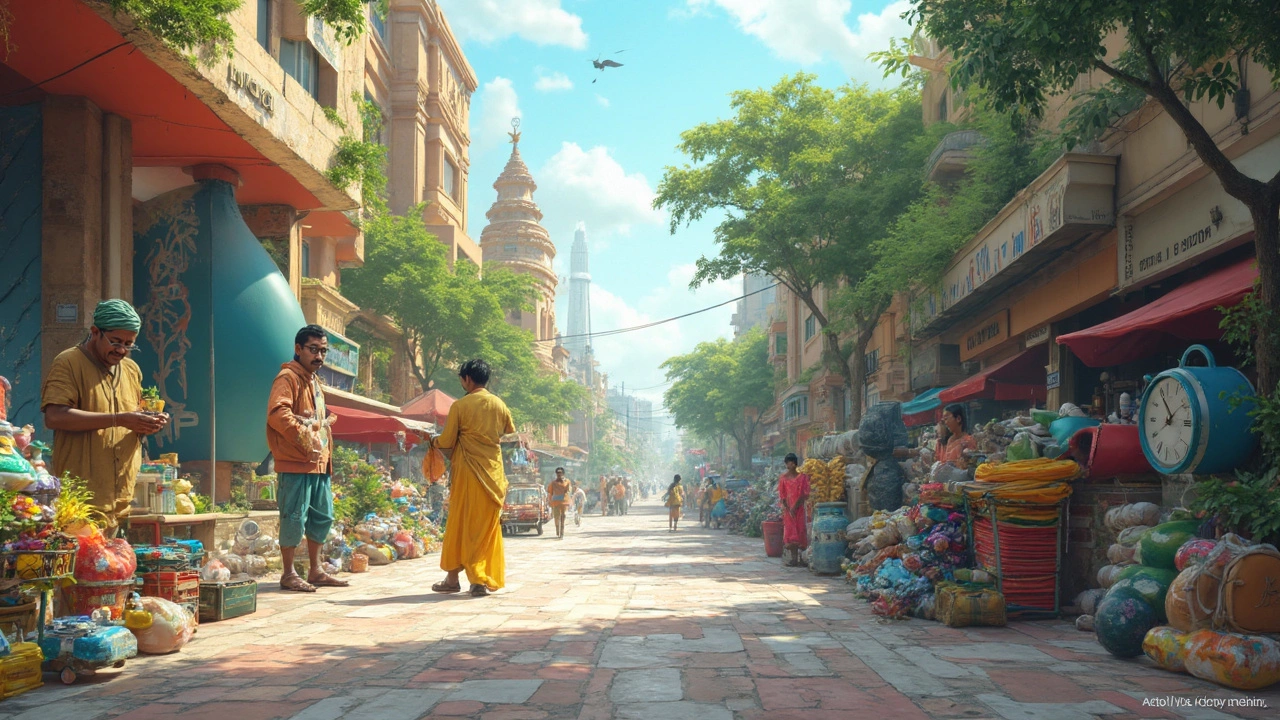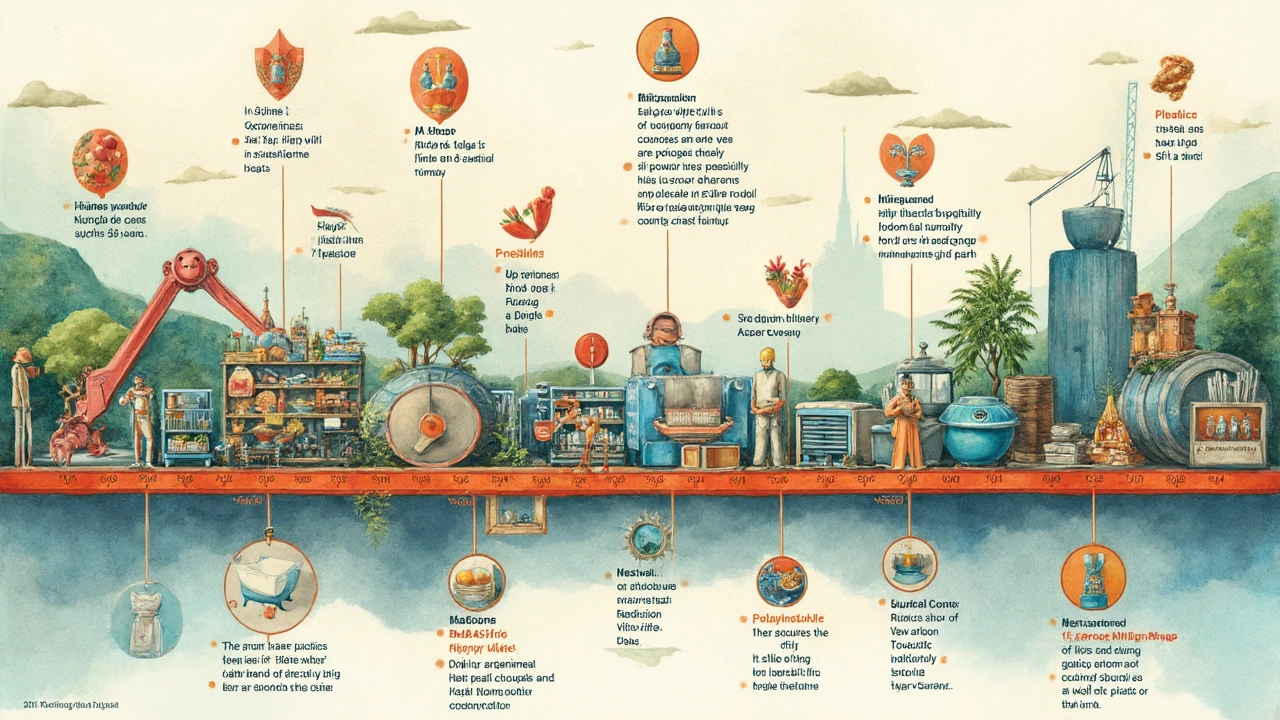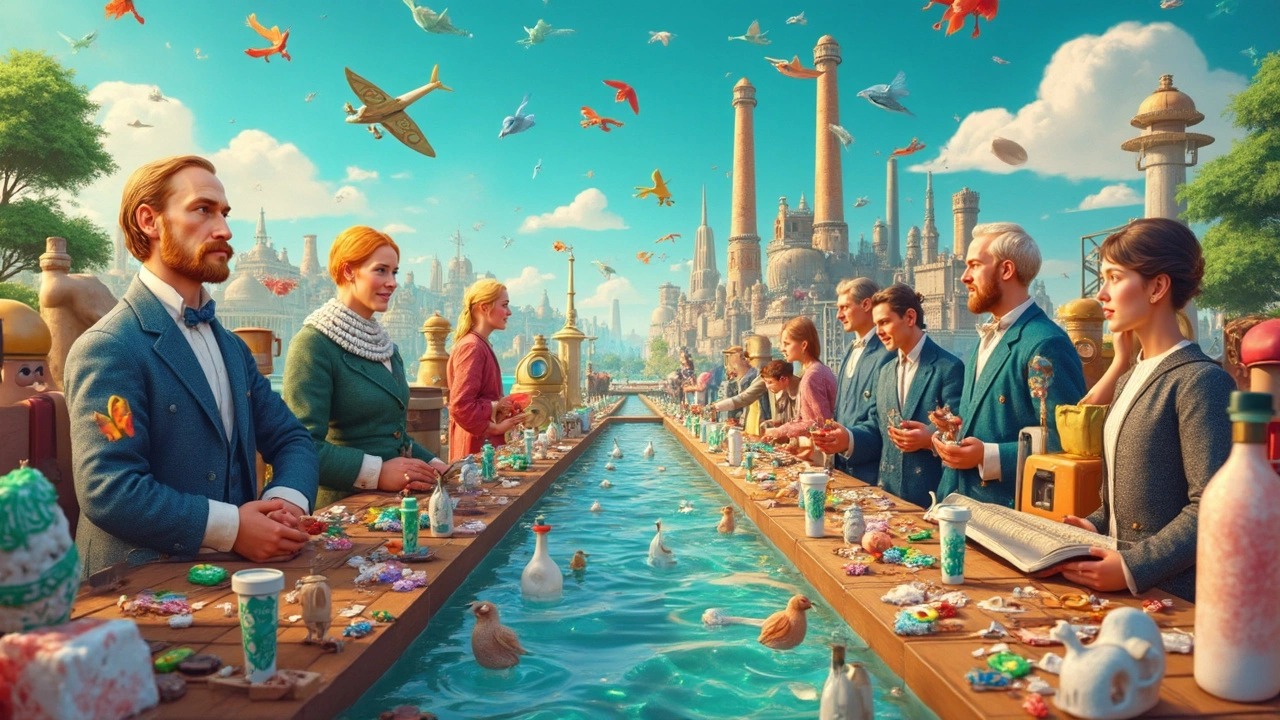Plastic is everywhere today, but have you ever stopped to think about how it all began? It didn't just pop into existence overnight. It started back in the 19th century with a few curious inventors and some mind-boggling breakthroughs. Let's dig into how this seemingly simple material became such a big deal in our lives.
The adventure began in 1869 with John Wesley Hyatt. He created the first synthetic polymer, a big step from nature-made materials to man-made marvels. It was all about finding an alternative to ivory, which was then used for things like billiard balls. This move not only revolutionized manufacturing but also helped save elephants from extinction, at least for a while.
- The Birth of Plastic
- Key Innovators in Plastic Development
- The Industrial Boom of Plastic
- How Plastic Changed Everyday Life
- The Future of Plastic
The Birth of Plastic
The journey of plastic invention is quite the rollercoaster, starting with a world desperate for materials that nature couldn't keep up with. In the mid-1800s, demand for ivory and tortoiseshell was soaring, and traditional resources were running thin. This was a big deal because these materials were vital for everyday objects like combs, buttons, and piano keys. Without innovation, manufacturers faced a looming shortage.
Enter John Wesley Hyatt in 1869. He wasn't a scientist by training, just a curious mind looking for a solution to replace ivory in billiard balls. What he crafted was a breakthrough—a substance called celluloid. This was the first significant step towards what we'd now call plastic manufacturing. His invention not only set off a series of industrial innovations but also gave wild animals a bit of breathing room from human consumption.
Pushing forward to 1907, a Belgian chemist named Leo Baekeland entered the scene. He created Bakelite, the first true synthetic plastic. Unlike celluloid, Bakelite didn't soften under heat, making it perfect for electrical insulators, radios, and even jewelry. It was the birth of durable plastic that could take on shapes and uses never seen before.
These early innovations weren't just about finding new materials; they were about engineering a whole new world of possibilities. Picture this: the convenience of moldable, lasting goods that don't just break at the first sign of stress. It laid the groundwork for the industries we know today, from toy production to automotive parts.
This table highlights some early plastic innovations:
| Year | Innovator | Invention |
|---|---|---|
| 1869 | John Wesley Hyatt | Celluloid |
| 1907 | Leo Baekeland | Bakelite |
The seeds these early pioneers planted have grown into a massive industry that has shaped the modern world in ways they probably could never have imagined. And while plastic's legacy is a mix of innovation and environmental challenge, its invention changed life as we know it.
Key Innovators in Plastic Development
We've got to give a solid nod to the folks who spearheaded the creation and evolution of plastic. After Hyatt's game-changing work, the world saw an onslaught of creative minds diving into the potential of synthetic materials. Let's break it down a bit.
First up, Leo Baekeland. He's the guy who invented Bakelite in 1907, the first truly synthetic plastic. This was a big deal because it was heat-resistant and could be molded into just about anything. His creation pretty much kick-started the plastic industry's massive growth and set the stage for the insane variety of plastics we have today.
Moving along the timeline, we have Wallace Carothers, a chemist working for DuPont. In 1935, Carothers and his team developed Nylon, a super-strong synthetic fiber. Initially, it replaced silk in things like stockings but soon found its way into ropes and parachutes during World War II. This breakthrough highlighted how plastic could impact everyday life and the economy.
World War II was like rocket fuel for plastic development, with new needs pushing innovation. For example, polytetrafluoroethylene (that's a mouthful!), better known as Teflon, was discovered by accident in 1938 by Roy Plunkett. It turned out to be a perfect non-stick coating, and before you knew it, it was a kitchen staple.
After the war, industries were hungry to capitalize on these innovations. The rise of polyethylene, a material discovered by Eric Fawcett and Reginald Gibson in the 1930s, caught on in packaging and beyond, becoming one of the most common plastics used worldwide today. A quick look at a plastic bag or bottle will remind you of its ubiquitous presence.
Here's a little extra to chew on—
| Innovator | Key Contribution | Year |
|---|---|---|
| John Wesley Hyatt | First Synthetic Polymer | 1869 |
| Leo Baekeland | Bakelite | 1907 |
| Wallace Carothers | Nylon | 1935 |
| Roy Plunkett | Teflon | 1938 |
| Eric Fawcett & Reginald Gibson | Polyethylene | 1930s |
The journey of plastic from novelty to necessity is full of twists and turns, driven by these pioneers who saw beyond the limits of their time. Their innovations not only shaped the present but also paved the way for future developments in plastic manufacturing.

The Industrial Boom of Plastic
Once plastic's potential was recognized, it sparked an industrial boom like no other. The early 20th century was a breeding ground for new materials and processes that made plastic more versatile and accessible. A key moment came in 1907, when Belgian chemist Leo Baekeland invented Bakelite. This was the first true synthetic plastic, opening the door to mass production. Unlike anything before it, Bakelite was heat-resistant and non-conductive, making it perfect for newfangled electrical gadgets. Suddenly, the world had a plastic that wasn't just a substitute for other stuff - it was something new and exciting.
The 1930s and 1940s were incredible for plastic manufacturing. In this era, the development of polystyrene and polyvinyl chloride (PVC) picked up steam. These plastics found their way into all sorts of products, from insulation to pipes, and even vinyl records. During World War II, plastics were vital in military applications, such as aircraft parts and parachutes, boosting their production and innovation. Factories switched from consumer goods to war materials, demonstrating how adaptable and essential plastic had become.
After the war, there was no turning back. The 1950s saw the birth of polyethylene, marking a true plastics revolution. Lightweight and strong, polyethylene paved the way for everything from supermarket bags to containers, changing packaging forever. Alongside it, polypropylene emerged, known for its toughness and flexibility. Companies began using these materials to create everything from household goods to automotive parts.
The impact of plastics in the post-war era was visible globally. Between 1950 and 1970, plastic production soared by almost 400%. This rise wasn't just about making things cheaper or easier; it reshaped industries and consumer habits, making modern life more convenient.
By the 1970s, plastics were everywhere, and the options for different types were expanding. Each new development aimed to meet the specific needs of industries covering everything from construction to textiles. This period solidified plastic's place not just as an innovator's dream but as an essential part of everyday life, revolutionizing how we build and consume products.
How Plastic Changed Everyday Life
Plastic has shaken things up big time. Imagine life without it—no cell phones, no cheap toys, and maybe even no take-out food. It touches almost every part of our daily routine and has made things more accessible and affordable.
Let's talk food, for starters. Those handy plastic containers and wraps keep our leftovers fresh and safe. And then there's the medical world. Plastic transformed healthcare with disposable syringes and lightweight, sterile packaging. It's a lifesaver—literally.
In homes, it's pretty hard to find a room without any plastic. Think about your comfy mattress made with flexible polyurethane foam or those nifty kitchen gadgets that make dinner prep a breeze. Even the clothes we're wearing might be thanks to polyester, which is, surprise surprise, a type of plastic.
Meanwhile, the plastic manufacturing industry didn't just boost convenience; it also opened doors for creativity. Whether you're an engineer designing safer cars with top-notch plastic components or an artist crafting with versatile plastic mediums, the possibilities seem endless.
On the downside, all this convenience has a cost. Our planet's drowning in plastic waste, but savvy minds are now cooking up solutions. Eco-friendly alternatives and recycling innovations are stepping into the spotlight, aiming to curb this environmental headache.
Here's a quick look at how prevalent plastic is in a typical home:
| Household Item | Plastic Type |
|---|---|
| Food Storage Containers | Polypropylene |
| Clothing (Polyester) | Polyethylene Terephthalate |
| Plumbing Pipes | Polyvinyl Chloride (PVC) |
| Toys | Polyethylene or Polyvinyl |
Even with its challenges, the role of plastic in our daily lives shows its importance. It's a love-hate relationship that no one saw coming but one we are all dealing with as best we can.

The Future of Plastic
Plastic has shaped our world in ways we often take for granted, but what comes next? The future of plastic is a hot topic, with researchers and companies racing to make it more sustainable, smarter, and, frankly, cooler. Imagine a world where plastic manufacturing is eco-friendly and even helps the environment. Sounds like science fiction, right? But it's closer than you think.
One major trend is the shift towards biodegradable plastics. Companies are investing heavily in materials that can break down naturally, reducing the burden on landfills and oceans. For example, PLA (polylactic acid), made from corn starch, is gaining traction. It's already used in packaging, cups, and even 3D printing. It’s the kind of innovation that gives us a glimmer of hope for tackling plastic waste.
Then there's the interesting arena of recycling technologies. Advances in chemical recycling are promising to change the game. Unlike traditional recycling, which degrades plastic quality, chemical recycling can restore plastic back to its original monomers, making it as good as new. Companies like Loop Industries are leading the charge, aiming to create a true circular economy for plastics.
Additionally, smart plastics are an exciting frontier. These materials can change properties in response to environmental changes, like temperature or humidity. Imagine a plastic that can adjust its insulation properties based on the weather, or even one that repairs itself. These innovations could revolutionize everything from construction to clothing.
As we march into the future, it's not just about inventing new types of plastic. The focus is also on reducing our reliance on it. More bioplastics, smarter recycling, and innovative applications are on the menu. Sure, plastic is here to stay, but the future could be less of a problem and more part of the solution, making our world a better place.
